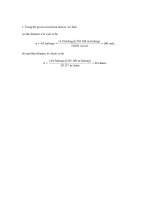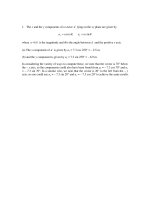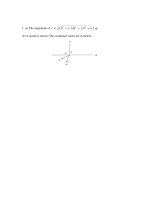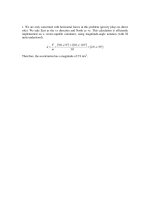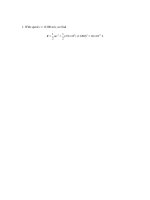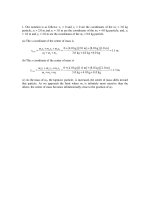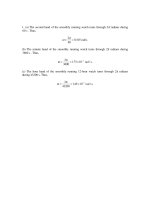Solution manual fundamentals of physics extended, 8th editionch17
Bạn đang xem bản rút gọn của tài liệu. Xem và tải ngay bản đầy đủ của tài liệu tại đây (915.03 KB, 113 trang )
1. The time it takes for a soldier in the rear end of the column to switch from the left to
the right foot to stride forward is t = 1 min/120 = 1/120 min = 0.50 s. This is also the time
for the sound of the music to reach from the musicians (who are in the front) to the rear
end of the column. Thus the length of the column is
l = vt = (343m/s)(0.50s) =1.7 × 102 m.
2. (a) When the speed is constant, we have v = d/t where v = 343 m/s is assumed.
Therefore, with t = 15/2 s being the time for sound to travel to the far wall we obtain d =
(343 m/s) × (15/2 s) which yields a distance of 2.6 km.
(b) Just as the
1
2
factor in part (a) was 1/(n + 1) for n = 1 reflection, so also can we write
( 343)(15) − 1
§ 15s ·
d = ( 343m/s ) ¨
¸ n=
d
© n +1 ¹
for multiple reflections (with d in meters). For d = 25.7 m, we find n = 199 ≈ 2.0 ×102 .
3. (a) The time for the sound to travel from the kicker to a spectator is given by d/v, where
d is the distance and v is the speed of sound. The time for light to travel the same distance
is given by d/c, where c is the speed of light. The delay between seeing and hearing the
kick is ∆t = (d/v) – (d/c). The speed of light is so much greater than the speed of sound
that the delay can be approximated by ∆t = d/v. This means d = v ∆t. The distance from
the kicker to spectator A is dA = v ∆tA = (343 m/s)(0.23 s) = 79 m.
(b) The distance from the kicker to spectator B is dB = v ∆tB = (343 m/s)(0.12 s) = 41 m.
(c) Lines from the kicker to each spectator and from one spectator to the other form a
right triangle with the line joining the spectators as the hypotenuse, so the distance
between the spectators is
D = d A2 + d B2 =
( 79 m )
2
+ ( 41m ) = 89 m .
2
4. The density of oxygen gas is
ρ=
From v =
0.0320 kg
= 1.43kg/m3.
3
0.0224 m
B / ρ we find
B = v 2 ρ = ( 317 m/s ) (1.43kg/m3 ) = 1.44 × 105 Pa.
2
5. Let tf be the time for the stone to fall to the water and ts be the time for the sound of the
splash to travel from the water to the top of the well. Then, the total time elapsed from
dropping the stone to hearing the splash is t = tf + ts. If d is the depth of the well, then the
kinematics of free fall gives d = 12 gt 2f , or t f = 2d / g . The sound travels at a constant
speed vs, so d = vsts, or ts = d/vs. Thus the total time is t = 2d / g + d / vs . This equation is
to be solved for d. Rewrite it as
2
2
s
2d / g = t − d / vs and square both sides to obtain 2d/g =
2
t – 2(t/vs)d + (1 + v )d . Now multiply by g vs2 and rearrange to get
gd2 – 2vs(gt + vs)d + g vs2 t2 = 0.
This is a quadratic equation for d. Its solutions are
2vs ( gt + vs ) ± 4vs2 ( gt + vs ) − 4 g 2vs2t 2
2
d=
2g
.
The physical solution must yield d = 0 for t = 0, so we take the solution with the negative
sign in front of the square root. Once values are substituted the result d = 40.7 m is
obtained.
6. Let A be the length of the rod. Then the time of travel for sound in air (speed vs) will be
ts = A / vs . And the time of travel for compressional waves in the rod (speed vr) will be
tr = A / vr . In these terms, the problem tells us that
§1 1·
ts − tr = 0.12s = A ¨ − ¸ .
© vs vr ¹
Thus, with vs = 343 m/s and vr = 15vs = 5145 m/s, we find A = 44 m .
7. If d is the distance from the location of the earthquake to the seismograph and vs is the
speed of the S waves then the time for these waves to reach the seismograph is ts. = d/vs.
Similarly, the time for P waves to reach the seismograph is tp = d/vp. The time delay is
∆t = (d/vs) – (d/vp) = d(vp – vs)/vsvp,
so
d=
vs v p ∆t
( v p − vs )
=
(4.5 km/s)(8.0 km/s)(3.0 min)(60s /min)
= 1.9 × 103 km.
8.0 km/s − 4.5 km/s
We note that values for the speeds were substituted as given, in km/s, but that the value
for the time delay was converted from minutes to seconds.
8. (a) The amplitude of a sinusoidal wave is the numerical coefficient of the sine (or
cosine) function: pm = 1.50 Pa.
(b) We identify k = 0.9π and ω = 315π (in SI units), which leads to f = ω/2π = 158 Hz.
(c) We also obtain λ = 2π/k = 2.22 m.
(d) The speed of the wave is v = ω/k = 350 m/s.
9. (a) Using λ = v/f, where v is the speed of sound in air and f is the frequency, we find
λ=
343 m/s
= 7.62 × 10−5 m.
6
4.50 × 10 Hz
(b) Now, λ = v/f, where v is the speed of sound in tissue. The frequency is the same for air
and tissue. Thus
λ = (1500 m/s)/(4.50 × 106 Hz) = 3.33 × 10–4 m.
10. Without loss of generality we take x = 0, and let t = 0 be when s = 0. This means the
phase is φ = −π/2 and the function is s = (6.0 nm)sin(ωt) at x = 0. Noting that ω = 3000
rad/s, we note that at t = sin−1(1/3)/ω = 0.1133 ms the displacement is s = +2.0 nm.
Doubling that time (so that we consider the excursion from –2.0 nm to +2.0 nm) we
conclude that the time required is 2(0.1133 ms) = 0.23 ms.
11. (a) Consider a string of pulses returning to the stage. A pulse which came back just
before the previous one has traveled an extra distance of 2w, taking an extra amount of
time ∆t = 2w/v. The frequency of the pulse is therefore
f =
1
v
343m/s
=
=
= 2.3 × 102 Hz.
∆t 2 w 2 ( 0.75m )
(b) Since f ∝ 1/w, the frequency would be higher if w were smaller.
12. The problem says “At one instant..” and we choose that instant (without loss of
generality) to be t = 0. Thus, the displacement of “air molecule A” at that instant is
sA = +sm = smcos(kxA − ωt + φ)|t=0 = smcos(kxA + φ),
where xA = 2.00 m. Regarding “air molecule B” we have
1
sB = + 3 sm = sm cos( kxB − ωt + φ )|t=0 = sm cos( kxB + φ ).
These statements lead to the following conditions:
kxA + φ = 0
kxB + φ = cos−1(1/3) = 1.231
where xB = 2.07 m. Subtracting these equations leads to
k(xB − xA) = 1.231 k = 17.6 rad/m.
Using the fact that k = 2π/λ we find λ = 0.357 m, which means
f = v/λ = 343/0.357 = 960 Hz.
Another way to complete this problem (once k is found) is to use kv = ω and then the
fact that ω = 2πf.
13. (a) The period is T = 2.0 ms (or 0.0020 s) and the amplitude is ∆pm = 8.0 mPa (which
is equivalent to 0.0080 N/m2). From Eq. 17-15 we get
sm =
∆pm
∆pm
=
= 6.1 × 10−9 m .
vρω
vρ(2π/T)
where ρ = 1.21 kg/m3 and v = 343 m/s.
(b) The angular wave number is k = ω/v = 2π/vT = 9.2 rad/m.
(c) The angular frequency is ω = 2π/T = 3142 rad/s ≈ 3.1 × 103 rad/s .
The results may be summarized as s(x, t) = (6.1 nm) cos[(9.2 m−1)x – (3.1 × 103 s−1)t].
(d) Using similar reasoning, but with the new values for density ( ρ ′ = 1.35 kg/m3) and
speed ( v′ = 320 m/s), we obtain
sm =
∆pm
∆pm
=
= 5.9 ×10−9 m.
v ' ρ 'ω v ' ρ '(2π / T )
(e) The angular wave number is k = ω/v’ = 2π/v’T = 9.8 rad/m.
(f) The angular frequency is ω = 2π/T = 3142 rad/s ≈ 3.1×103 rad/s .
The new displacement function is s(x, t) = (5.9 nm) cos[(9.8 m−1)x – (3.1 × 103 s−1)t].
14. Let the separation between the point and the two sources (labeled 1 and 2) be x1 and
x2, respectively. Then the phase difference is
§x
·
§x
· 2π ( x1 − x2 )
∆φ = φ1 − φ2 = 2π ¨ 1 + ft ¸ − 2π ¨ 2 + ft ¸ =
λ
©λ
¹
©λ
¹
2π (4.40 m − 4.00 m)
=
= 4.12 rad.
(330 m/s) / 540 Hz
15. (a) The problem is asking at how many angles will there be “loud” resultant waves,
and at how many will there be “quiet” ones? We note that at all points (at large distance
from the origin) along the x axis there will be quiet ones; one way to see this is to note
that the path-length difference (for the waves traveling from their respective sources)
divided by wavelength gives the (dimensionless) value 3.5, implying a half-wavelength
(180º) phase difference (destructive interference) between the waves. To distinguish the
destructive interference along the +x axis from the destructive interference along the –x
axis, we label one with +3.5 and the other –3.5. This labeling is useful in that it suggests
that the complete enumeration of the quiet directions in the upper-half plane (including
the x axis) is: –3.5, –2.5, –1.5, –0.5, +0.5, +1.5, +2.5, +3.5. Similarly, the complete
enumeration of the loud directions in the upper-half plane is: –3, –2, –1, 0, +1, +2, +3.
Counting also the “other” –3, –2, –1, 0, +1, +2, +3 values for the lower-half plane, then
we conclude there are a total of 7 + 7 = 14 “loud” directions.
(b) The discussion about the “quiet” directions was started in part (a). The number of
values in the list: –3.5, –2.5, –1.5, –0.5, +0.5, +1.5, +2.5, +3.5 along with –2.5, –1.5, –0.5,
+0.5, +1.5, +2.5 (for the lower-half plane) is 14. There are 14 “quiet” directions.
16. At the location of the detector, the phase difference between the wave which traveled
straight down the tube and the other one which took the semi-circular detour is
∆φ = k ∆d =
2π
( πr − 2 r ).
λ
For r = rmin we have ∆φ = π, which is the smallest phase difference for a destructive
interference to occur. Thus
rmin =
λ
40.0cm
=
= 17.5cm.
2( π − 2) 2( π − 2)
17. Let L1 be the distance from the closer speaker to the listener. The distance from the
other speaker to the listener is L2 = L12 + d 2 , where d is the distance between the
speakers. The phase difference at the listener is φ = 2π(L2 – L1)/λ, where λ is the
wavelength.
For a minimum in intensity at the listener, φ = (2n + 1)π, where n is an integer. Thus λ =
2(L2 – L1)/(2n + 1). The frequency is
f =
v
=
λ 2
(
(2n + 1)v
L12 + d 2 − L1
=
) (
2
(2n + 1)(343m/s)
(3.75m)2 + (2.00 m) 2 − 3.75m
)
= (2n + 1)(343Hz).
Now 20,000/343 = 58.3, so 2n + 1 must range from 0 to 57 for the frequency to be in the
audible range. This means n ranges from 0 to 28.
(a) The lowest frequency that gives minimum signal is (n = 0) f min,1 = 343 Hz.
(b) The second lowest frequency is (n = 1) f min,2 = [2(1) + 1]343 Hz = 1029 Hz = 3 f min,1.
Thus, the factor is 3.
(c) The third lowest frequency is (n=2) f min,3 = [2(2) + 1]343 Hz = 1715 Hz = 5 f min,1. Thus,
the factor is 5.
For a maximum in intensity at the listener, φ = 2nπ, where n is any positive integer. Thus
λ = (1/ n )
(
)
L12 + d 2 − L1 and
f =
v
=
λ
nv
L + d − L1
2
1
2
=
n (343m/s)
(3.75m) + (2.00 m)2 − 3.75 m
2
= n (686 Hz).
Since 20,000/686 = 29.2, n must be in the range from 1 to 29 for the frequency to be
audible.
(d) The lowest frequency that gives maximum signal is (n =1) f max,1 = 686 Hz.
(e) The second lowest frequency is (n = 2) f max,2 = 2(686 Hz) = 1372 Hz = 2 f max,1. Thus,
the factor is 2.
(f) The third lowest frequency is (n = 3) f max,3 = 3(686 Hz) = 2058 Hz = 3 f max,1. Thus, the
factor is 3.
18. (a) The problem indicates that we should ignore the decrease in sound amplitude
which means that all waves passing through point P have equal amplitude. Their
superposition at P if d = λ/4 results in a net effect of zero there since there are four
sources (so the first and third are λ/2 apart and thus interfere destructively; similarly for
the second and fourth sources).
(b) Their superposition at P if d = λ/2 also results in a net effect of zero there since there
are an even number of sources (so the first and second being λ/2 apart will interfere
destructively; similarly for the waves from the third and fourth sources).
(c) If d = λ then the waves from the first and second sources will arrive at P in phase;
similar observations apply to the second and third, and to the third and fourth sources.
Thus, four waves interfere constructively there with net amplitude equal to 4sm.
19. Building on the theory developed in §17 – 5, we set ∆L / λ = n − 1/ 2, n = 1, 2,... in
order to have destructive interference. Since v = fλ, we can write this in terms of
frequency:
f min,n =
(2n − 1)v
= (n − 1/ 2)(286 Hz)
2∆L
where we have used v = 343 m/s (note the remarks made in the textbook at the beginning
of the exercises and problems section) and ∆L = (19.5 – 18.3 ) m = 1.2 m.
(a) The lowest frequency that gives destructive interference is (n = 1)
f min,1 = (1 − 1/ 2)(286 Hz) = 143 Hz.
(b) The second lowest frequency that gives destructive interference is (n = 2)
f min,2 = (2 − 1/ 2)(286 Hz) = 429 Hz = 3(143 Hz) = 3 f min,1.
So the factor is 3.
(c) The third lowest frequency that gives destructive interference is (n = 3)
f min,3 = (3 − 1/ 2)(286 Hz) = 715 Hz = 5(143 Hz) = 5 f min,1.
So the factor is 5.
Now we set ∆L / λ = 12 (even numbers) — which can be written more simply as “(all
integers n = 1, 2,…)” — in order to establish constructive interference. Thus,
f max,n =
nv
= n(286 Hz).
∆L
(d) The lowest frequency that gives constructive interference is (n =1) f max,1 = (286 Hz).
(e) The second lowest frequency that gives constructive interference is (n = 2)
f max,2 = 2(286 Hz) = 572 Hz = 2 f max,1 .
Thus, the factor is 2.
(f) The third lowest frequency that gives constructive interference is (n = 3)
f max,3 = 3(286 Hz) = 858 Hz = 3 f max,1.
Thus, the factor is 3.
20. (a) If point P is infinitely far away, then the small distance d between the two sources
is of no consequence (they seem effectively to be the same distance away from P). Thus,
there is no perceived phase difference.
(b) Since the sources oscillate in phase, then the situation described in part (a) produces
constructive interference.
(c) For finite values of x, the difference in source positions becomes significant. The path
lengths for waves to travel from S1 and S2 become now different. We interpret the
question as asking for the behavior of the absolute value of the phase difference |∆φ|, in
which case any change from zero (the answer for part (a)) is certainly an increase.
The path length difference for waves traveling from S1 and S2 is
∆A = d 2 + x 2 − x
for x > 0.
The phase difference in “cycles” (in absolute value) is therefore
∆φ =
∆A
d 2 + x2 − x
=
.
λ
λ
Thus, in terms of λ, the phase difference is identical to the path length difference:
| ∆φ | = ∆A > 0 . Consider ∆A = l/ 2 . Then
rearranging, and solving, we find
x=
d 2 + x 2 = x + λ / 2 . Squaring both sides,
d2 λ
− .
λ 4
In general, if D A = xl for some multiplier ξ > 0, we find
x=
d2 1
64.0
− ξλ =
−ξ
ξ
2ξλ 2
where we have used d = 16.0 m and λ = 2.00 m.
(d) For D A = 0.50l , or ξ = 0.50 , we have x = (64.0/0.50 − 0.50) m = 127.5 m ≈ 128 m .
(e) For D A = 1.00l , or ξ = 1.00 , we have x = (64.0/1.00 − 1.00) m = 63.0 m .
(f) For D A = 1.50l , or ξ = 1.50 , we have x = (64.0/1.50 − 1.50) m = 41.2 m .
Note that since whole cycle phase differences are equivalent (as far as the wave
superposition goes) to zero phase difference, then the ξ = 1, 2 cases give constructive
interference. A shift of a half-cycle brings “troughs” of one wave in superposition with
“crests” of the other, thereby canceling the waves; therefore, the ξ = 12 , 32 , 52 cases
produce destructive interference.
21. The intensity is the rate of energy flow per unit area perpendicular to the flow. The
rate at which energy flow across every sphere centered at the source is the same,
regardless of the sphere radius, and is the same as the power output of the source. If P is
the power output and I is the intensity a distance r from the source, then P = IA = 4πr2I,
where A (= 4πr2) is the surface area of a sphere of radius r. Thus
P = 4π(2.50 m)2 (1.91 × 10–4 W/m2) = 1.50 × 10–2 W.
22. (a) Since intensity is power divided by area, and for an isotropic source the area may
be written A = 4πr2 (the area of a sphere), then we have
I=
P
1.0 W
=
= 0.080 W/m 2 .
A 4 π(1.0 m) 2
(b) This calculation may be done exactly as shown in part (a) (but with r = 2.5 m instead
of r = 1.0 m), or it may be done by setting up a ratio. We illustrate the latter approach.
Thus,
I ′ P / 4 π( r ′)2 § r ·
=
=¨ ¸
I
P / 4 πr 2
© r′ ¹
leads to I′ = (0.080 W/m2)(1.0/2.5)2 = 0.013 W/m2.
2
23. The intensity is given by I = 12 ρ vω 2 sm2 , where ρ is the density of air, v is the speed of
sound in air, ω is the angular frequency, and sm is the displacement amplitude for the
sound wave. Replace ω with 2πf and solve for sm:
sm =
I
2π 2 ρ v f 2
=
1.00 × 10−6 W/m 2
= 3.68 ×10−8 m.
2π2 (1.21kg/m3 )(343m/s)(300 Hz) 2
